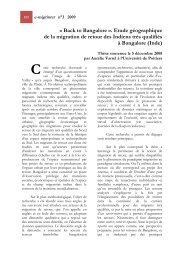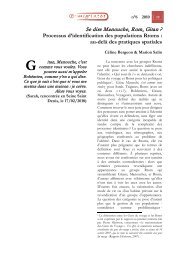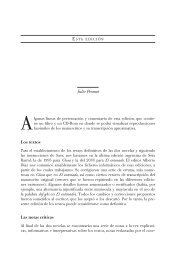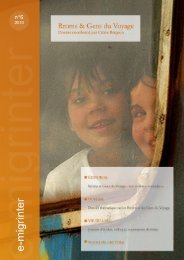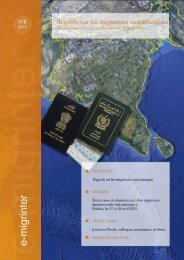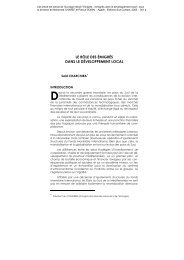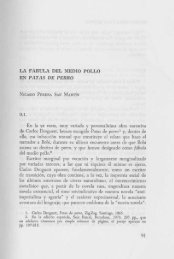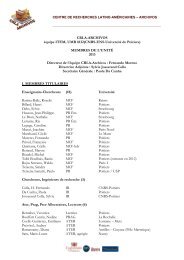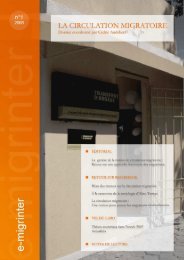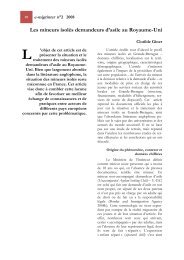e-migrinter 2010 numéro 05 - Maison des Sciences de l'Homme et ...
e-migrinter 2010 numéro 05 - Maison des Sciences de l'Homme et ...
e-migrinter 2010 numéro 05 - Maison des Sciences de l'Homme et ...
You also want an ePaper? Increase the reach of your titles
YUMPU automatically turns print PDFs into web optimized ePapers that Google loves.
24 n°5 <strong>2010</strong><br />
Communicative comp<strong>et</strong>ence and its importance for<br />
integration in a multicultural school in rural Norway<br />
Ane Sætha<br />
I<br />
n the 19 th and early 20 th century<br />
many Norwegians migrated to<br />
North America. In early 1960s,<br />
however, the trend had turned, and<br />
during the last 30 years Norway<br />
has gradually become more diverse<br />
in terms of culture and religion.<br />
Norwegian politicians, amongst<br />
others, believe this has challenged<br />
the traditional thoughts of Norway<br />
as a culturally homogenous<br />
soci<strong>et</strong>y, and these new challenges<br />
and possibilities are creating new<br />
cultural impressions<br />
(Stortingsmelding 1 , 30,<br />
2003/2004, ch. 3). By the<br />
beginning of 2004, 7,6 % of the<br />
population in Norway were<br />
immigrants, 30 % of these came<br />
from the western world (Statistisk<br />
Sentralbyrå 2 , 2004).<br />
Introduction 3<br />
In the last few years, many<br />
parliamentary reports have focused on the<br />
increasing plurality and two points seems to<br />
be of special importance : first, it is about a<br />
multicultural soci<strong>et</strong>y and how a soci<strong>et</strong>y like<br />
this i<strong>de</strong>ally should be. Second it is about<br />
language literally, i.e. about Norwegian<br />
language and mother tongue teaching<br />
(Stortingsmelding, 17, 1996/1997 ; 25,<br />
1998/1999 ; 30, 2003/2004, 49, 2003/2004).<br />
The parliament reports, the national<br />
teaching plans and different public reports<br />
focus on the nature of an i<strong>de</strong>al soci<strong>et</strong>y, and<br />
don’t say anything about how to achieve it.<br />
Most politicians believe in <strong>de</strong>centralizing, so<br />
a lot of the asylum centers in Norway are<br />
placed outsi<strong>de</strong> the main cities, or in rural<br />
districts. The number of asylum centers<br />
varies, <strong>de</strong>pending on the need but usually<br />
b<strong>et</strong>ween 100 and 150 during the last few<br />
years that are connected to the Norwegian<br />
Directorate of Immigration.<br />
When it comes to integration,<br />
politicians take it for granted that a<br />
<strong>de</strong>centralizing policy is important, and that<br />
the schools are one of the most important<br />
institutions to achieve it. They assume that<br />
equality and knowledge about language will<br />
solve all problems ; and equality in all areas<br />
in the soci<strong>et</strong>y is quite simple, namely one<br />
only has to know about each other’s<br />
“culture” and respect it. The focus on<br />
language is only language literally, that is,<br />
only the language in itself and not other<br />
1 Parliamentary reports. These are reports from the<br />
government to the parliament, and contains<br />
suggestions and recommendations from various<br />
ministries.<br />
2 Statistics Norway http://www.ssb.no/english/.<br />
3 This article is based on fieldwork conducted during<br />
August to December 2003 as a part of masters <strong>de</strong>gree<br />
in social anthropology at the University of<br />
Copenhagen.



